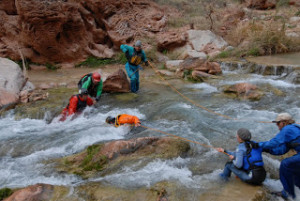Jeff Jackson, professor and coordinator of Algonquin College’s Outdoor Adventure Program, and co-author of “Managing Risk – Systems Planning for Outdoor Adventure Programs” (2011), in a recent webinar, makes the point that “safe failure” is more important than being “fail safe” during the planning and conduct of an outdoor program.
“Fail safe” means that the participants are taught to only do the right thing under conditions normally encountered. Unfortunately, it is impossible to ensure that nothing out of the ordinary goes wrong, or that the conditions encountered are always those contemplated and planned for. And, once something goes wrong, the participants find themselves in uncertain territory.
But, at the edges of an activity, there are risks that the participants may not normally confront, but may still arise (a swamped canoe or kayak, a climber falling while under belay, falling into a river during a crossing, exposure to extreme environmental risks). It is accordingly important for the participants to have adequate coping skills to permit such peripheral risks to be successfully overcome. For instance, practicing for a climber falling while under belay is not about the climber, it is about the belayer, and how the belayer functions under less than optimum conditions.

The takeaway is that spending time training participants to address those aspects of the activity that will normally be encountered does not provide any coping skills for those aspects of the activity that may not normally be encountered, but whose odds of encountering are real indeed.
For instance, potential canoe trek participants may normally practice paddling skills (different strokes, turning, etc.) prior to the trek. But, will the participants practice those aspects of the canoeing trek that may only occur at the periphery of normal operation, such as swamping, paddling in fast water, dealing with high waves, etc? Do you want the first time a participant (adult or youth) has to deal with a loaded swamped canoe be when it happens on the trek, when one or more participants also has to deal with the accompanying shock of being in the water fully clothed? Is it not more appropriate for the crew members to previously have acquired the requisite confidence that they can cope with events that happen at the edges of normal activity operation before they happen, particularly with youth involved? This is where the “Safe Failure” concept comes into play – learning to fail under safe conditions.

For instance, a hiking group caught in a weather system including lightning and potentially hypothermic conditions should already know how to deal with the symptoms of hypothermia, as well as the risks associated with lightning. It is thus important, of course, for Scouts to not only learn the rules of safe hiking, but how to deal with such risks if they occur. The Scouts will then acquire coping skills which they would be able to use with confidence if so called upon.
In summary, as Jeff stated in his webinar:
- “Spending training time in normal does not prepare for the non-normal”.
- “Meaningful interaction with the inherent risks of an activity builds coping skills at the boundaries of the activity.”
- And, “Personal experience in learning how to cope with non-normal circumstances has been found to be the best learning experience, as emotion accompanies the learning.”
Indeed, in his book “Progressive Pioneering” (1964), the author John Thurman states at page 14 “It is always right to begin to learn something in easy conditions but it is wrong to think that you are competent to use that skill unless you have practiced it in conditions of difficulty.”
Be Prepared!
